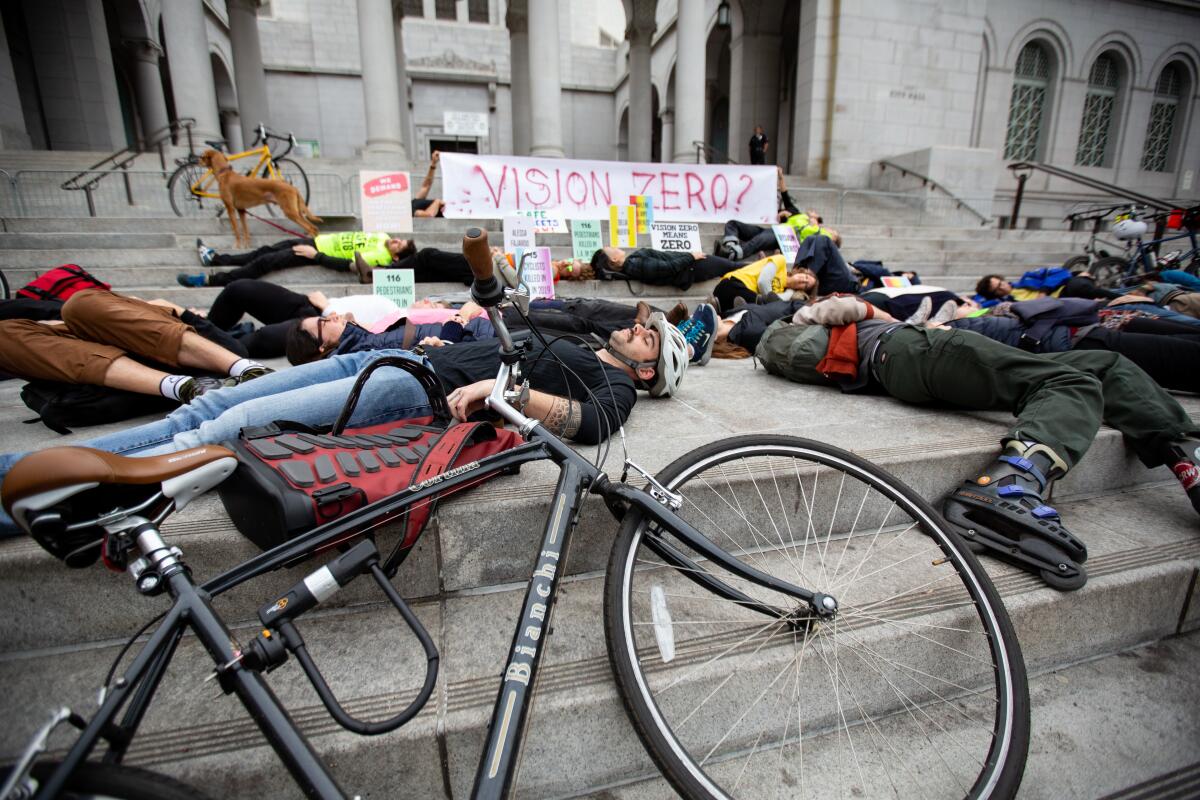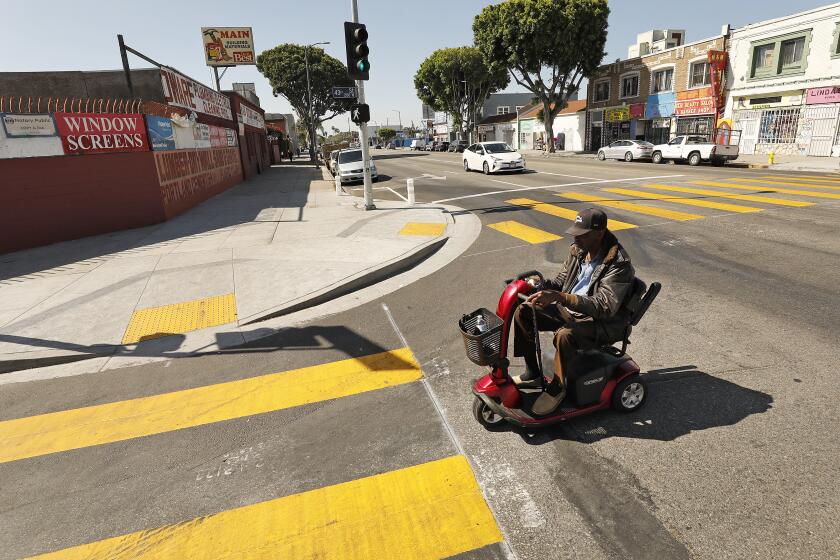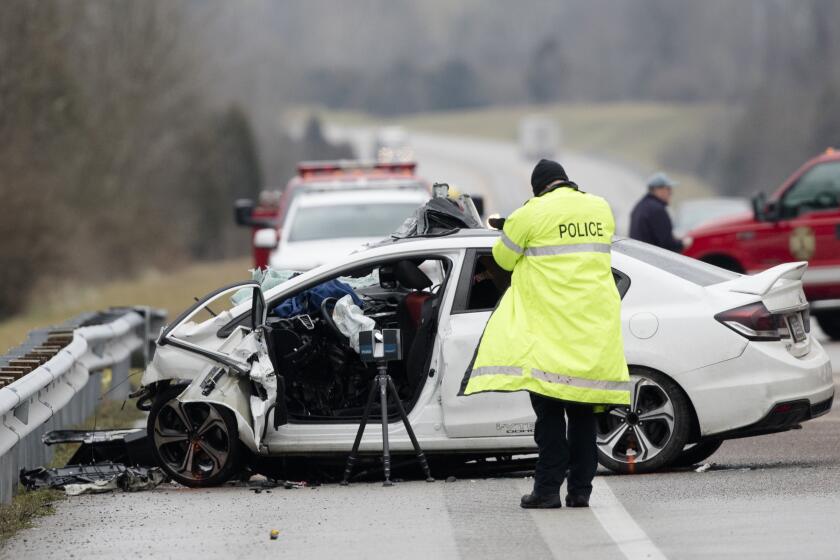Hundreds died in L.A. traffic crashes in 2021. Is Vision Zero a failure?

Mayor Eric Garcetti’s goal of ending traffic deaths by 2025 looks increasingly unattainable following another year of rising fatalities and injuries caused by motorists.
According to Los Angeles Police Department data through Dec. 25, 289 people were killed in traffic collisions last year, 21% more than the same period in 2020 and 19% over the same period in 2019. A total of 1,465 people were severely injured, a 30% increase over the same period in 2020. The LAPD defines severely injured as needing to be transported from the collision.
The city’s streets are increasingly dangerous for pedestrians in particular, with 486 being severely injured by motorists — a 35% increase over 2020. Pedestrian deaths rose 6% to 128.
The numbers frustrate transportation advocates, who’ve long argued that Vision Zero — a program to end traffic deaths unveiled in 2015 by Garcetti — is underfunded and given a low priority by the mayor and City Hall leaders.
“We’re nowhere near it,” said John Yi, executive director of Los Angeles Walks, of the goal of zero deaths. “This is a leadership failure at the city level.”
While 2021 data are still being analyzed, residents of L.A.’s underserved communities are disproportionately killed in traffic crashes, according to the Department of Transportation.
The “greatest risk intersections” through Dec. 25 were San Pedro Street and Washington Boulevard in South L.A., Florence Avenue and Vermont Avenue in South L.A., Oxnard Street and Van Nuys Boulevard in Van Nuys and Highland Avenue and Hollywood Boulevard in Hollywood, according to the LAPD.
LAPD Chief Michel Moore highlighted the violence on the roadways at a police commission meeting last month, where he urged the public to obey speed laws and cited the rising number of collisions.
“We’ve seen these dramatic increases,” Moore told the panel, drawing attention to the recent deaths of several pedestrians, including Arian Rahbar, a 21-year-old USC student who was struck by a racing motorist in South L.A., and an 85-year-old man from Reseda killed by a motorist. The L.A. County coroner identified the victim as Parviz Behna.
There is an epidemic of dying while walking, and it affects people of color and poor people disproportionately
Department of Transportation spokesman Colin Sweeney said the 2021 statistics point to “speeding and reckless driving, coupled with design trends that make cars deadlier than ever before, with heavier frames and the addition of distracting features.” He said the data would be analyzed for specific trends.
Los Angeles is far from alone in seeing an increase in traffic deaths. Nationwide, there was an 18% jump in traffic fatalities in the first six months of 2021, according to preliminary figures from the federal government. Transportation Secretary Pete Buttigieg in October called the trend a “crisis” that is also “preventable.”
The nationwide upward trend followed decades of safety gains, and the increased fatalities suggest the pandemic has made U.S. drivers more reckless — more likely to speed, drink or use drugs and leave their seat belts unbuckled.
L.A.’s pre-pandemic figures show overall fatalities from traffic collisions remained flat from 2017-2019 after dropping slightly from 2016’s numbers, according to Department of Transportation data. The number of pedestrians killed rose or remained flat during that time period, according to the department.
Collisions involving bicyclists that resulted in severe injuries were rising before the pandemic. The numbers rose again in 2021, up 24% through Dec. 25 compared to the same period in 2020. And 18 bicyclists were killed, an increase of 20%.
Garcetti cited the distraction of cellphones as a cause of collisions and said the city has added bike lanes during the pandemic, studied the city’s most dangerous intersections to come up with solutions, and supported a new state law designed to help cities have more control over speed limits.
“But it shows how tough it is,” Garcetti said Thursday.
He pushed back against criticism that he doesn’t mention Vision Zero as frequently as he touts other initiatives. “I speak out all the time,” Garcetti said. “I do on panels, I go out there, internationally, to kind of be part of this movement to make sure that we have more walkable, livable cities.”
The mayor launched the Vision Zero program in 2015, but failed to meet his first benchmark — to reduce traffic deaths by 20% by 2017. Vision Zero is based on the principle that traffic deaths can be avoided through engineering, enforcement, education, evaluation and community engagement.
Sweeney, the transportation department spokesman, said the city has performed thousands of street safety treatments along areas known to be at risk for collisions, targeting crosswalks, traffic signs, refuge islands and more. Key improvements were also made recently on Avalon and Adams boulevards, he said.
“Every traffic death is a tragedy, and this year’s deaths are a sobering reminder of how critical our work continues to be,” Sweeney said.
Some traffic measures have faced pushback from businesses and residents. Councilman Mike Bonin, who chairs the city’s transportation committee, faced a recall threat in 2017 by residents angry that a “road diet” in Playa del Rey — an initiative that removed lanes and added bikes lanes — increased their commute times. The car lanes were later restored.
Evidence suggests the pandemic has made U.S. drivers more reckless — more likely to speed, drink or use drugs and to leave their seatbelts unbuckled.
Bonin called the latest traffic collision statistics a “public health crisis” last week and called for additional resources.
“We need more funding, more staff, and more advocacy to better protect people in L.A., and I remain committed to this work,” Bonin said. He also cited a new state law that will allow Los Angeles and other cities to control speed limits on local roads.
Vision Zero topped $61 million in this year’s budget, according to the transportation department, while in recent years the program received between $26 million and $47 million. Those figures included money dedicated to other departments such as the Department of Engineering, the Bureau of Street Lighting and the LAPD, Sweeney said.
Seleta Reynolds, the head of the city’s Department of Transportation, said in 2017 that it could take as much as $80 million to achieve a 20% reduction in fatal and severe crashes involving pedestrians and cyclists.
“We need to prioritize Vision Zero, we need to fund Vision Zero,” said Tamika Butler, a transportation consultant whose clients include government agencies. She said the city needs to look for funding for the program from the police and fire departments.
“Our budget documents are our priority documents,” Butler added.
Michael Schneider, founder of Streets for All, is among those safe-street activists now turning their attention to the June primary election, when voters will weigh in on several city council races, as well as a mayoral race. L.A. remains “unnecessarily dangerous” for walkers and bicyclists, he said.
“We need to elect politicians in 2022 that will actually reallocate space from cars to make our streets safer for all,” Schneider said, “and not just pay lip service to Vision Zero.”
Times staff writers Emily Baumgaertner and Russ Mitchell contributed to this report.
More to Read
Sign up for Essential California
The most important California stories and recommendations in your inbox every morning.
You may occasionally receive promotional content from the Los Angeles Times.













